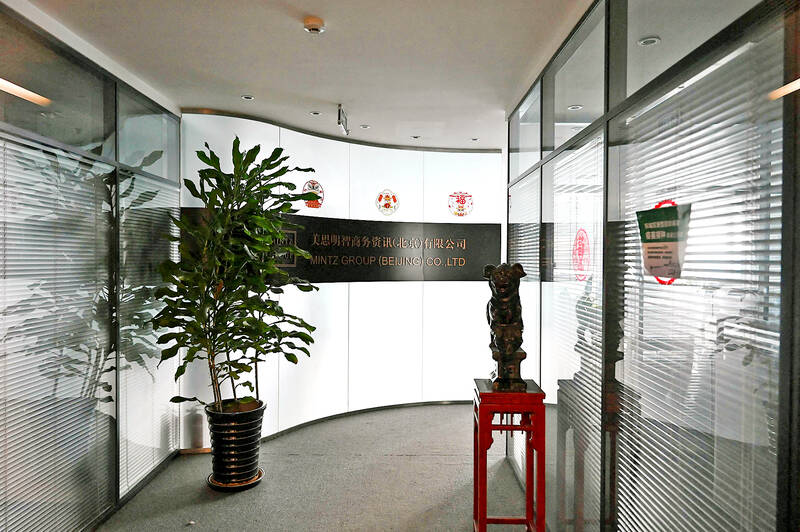Beijing curtailed access by overseas firms to Chinese data sources in part due to a series of reports written by US research institutions that alarmed officials, the Wall Street Journal reported, citing people with knowledge of the matter.
Senior officials grew concerned about research by US think tanks based on public local data sources that focused on sensitive issues such as collaboration between the military and private organizations, the Journal reported.
Those reports came from sources such as the Center for Security and Emerging Technology at Georgetown University and the Center for a New American Security, which was cofounded by US National Security Council Indo-Pacific Coordinator Kurt Campbell, the newspaper said.

Photo: AFP
Beijing is moving to tighten its grip on sensitive data as tensions with Washington mount. Despite the administration’s push to encourage investment into China this year, investors continue to grapple with a lack of transparency and information across swaths of the world’s second-largest economy.
Think tanks, research houses and consultancies seeking information on China’s economy have long relied on domestic sources to dive deeper into specific issues and industries.
However, Chinese services such as Wind Information Co (萬得資訊) in recent months stopped providing detailed data on the nation’s companies to overseas clients.
That coincided with a clampdown on foreign firms that regularly gather information on businesses in the country. Consultancies in particular are under the microscope, with Beijing in recent weeks targeting the local offices of Bain & Co, Mintz Group and Capvision, media reported.
The government last month passed a counter-espionage law that expanded the list of activities that could be considered spying.
“By taking crucial data off the table, public discourse on China will drift further from the truth. It’s a reckless move by China to limit access to the data,” said Dakota Cary, a China-focused consultant at Krebs Stamos Group. “The US-China relationship will be made worse by this decision.”
The Cyberspace Administration of China (CAC), the country’s powerful Internet overseer, notified data providers in March to restrict overseas access to sensitive information such as patents and statistics, the Journal reported, citing people who have consulted with Chinese authorities.
Organizations received notices in March warning about upcoming restrictions on services including the popular academic database China National Knowledge Infrastructure, the University of California, Berkeley said in an online notice.
“Many content types that were previously viewed as mundane have now been flagged by the Chinese authorities to be subject to government review,” the university’s library said.
“The duration of such suspensions is not yet known, but we have been told that access will resume upon CAC determining that Chinese publishers have addressed their requirements for the review of the affected content types,” it said.
One report that caught Beijing’s eye was a policy brief published by the Center for Security and Emerging Technology in June last year, titled “Silicon Twist,” the Journal said.
That report focused on the military’s access to US-designed chips intended to train artificial intelligence models. The authors said they analyzed thousands of purchasing records to draw their conclusions, and described steps that the US government could take to cut off that access.
Another, from the same center, zeroed in on how Beijing employed programs to track and recruit talent from around the globe to boost its strategic goals, the Journal reported.
The think tank had relied on sources including China National Knowledge Infrastructure, Center for Security and Emerging Technology spokeswoman Lynne Weil said.
However, it had no insight into what might have triggered information curbs, she said.
Chinese data has gradually become less available, Grow Investment Group (思睿對沖基金) chief economist Hao Hong (洪灝) told Bloomberg Television yesterday.
“People learn to get around the issue by using different data sources, but at the end of the day it’s becoming harder to analyze what’s going on in China,” he said.

CHIP RACE: Three years of overbroad export controls drove foreign competitors to pursue their own AI chips, and ‘cost US taxpayers billions of dollars,’ Nvidia said China has figured out the US strategy for allowing it to buy Nvidia Corp’s H200s and is rejecting the artificial intelligence (AI) chip in favor of domestically developed semiconductors, White House AI adviser David Sacks said, citing news reports. US President Donald Trump on Monday said that he would allow shipments of Nvidia’s H200 chips to China, part of an administration effort backed by Sacks to challenge Chinese tech champions such as Huawei Technologies Co (華為) by bringing US competition to their home market. On Friday, Sacks signaled that he was uncertain about whether that approach would work. “They’re rejecting our chips,” Sacks

Taiwan’s long-term economic competitiveness will hinge not only on national champions like Taiwan Semiconductor Manufacturing Co. (TSMC, 台積電) but also on the widespread adoption of artificial intelligence (AI) and other emerging technologies, a US-based scholar has said. At a lecture in Taipei on Tuesday, Jeffrey Ding, assistant professor of political science at the George Washington University and author of "Technology and the Rise of Great Powers," argued that historical experience shows that general-purpose technologies (GPTs) — such as electricity, computers and now AI — shape long-term economic advantages through their diffusion across the broader economy. "What really matters is not who pioneers

TAIWAN VALUE CHAIN: Foxtron is to fully own Luxgen following the transaction and it plans to launch a new electric model, the Foxtron Bria, in Taiwan next year Yulon Motor Co (裕隆汽車) yesterday said that its board of directors approved the disposal of its electric vehicle (EV) unit, Luxgen Motor Co (納智捷汽車), to Foxtron Vehicle Technologies Co (鴻華先進) for NT$787.6 million (US$24.98 million). Foxtron, a half-half joint venture between Yulon affiliate Hua-Chuang Automobile Information Technical Center Co (華創車電) and Hon Hai Precision Industry Co (鴻海精密), expects to wrap up the deal in the first quarter of next year. Foxtron would fully own Luxgen following the transaction, including five car distributing companies, outlets and all employees. The deal is subject to the approval of the Fair Trade Commission, Foxtron said. “Foxtron will be

BUBBLE? Only a handful of companies are seeing rapid revenue growth and higher valuations, and it is not enough to call the AI trend a transformation, an analyst said Artificial intelligence (AI) is entering a more challenging phase next year as companies move beyond experimentation and begin demanding clear financial returns from a technology that has delivered big gains to only a small group of early adopters, PricewaterhouseCoopers (PwC) Taiwan said yesterday. Most organizations have been able to justify AI investments through cost recovery or modest efficiency gains, but few have achieved meaningful revenue growth or long-term competitive advantage, the consultancy said in its 2026 AI Business Predictions report. This growing performance gap is forcing executives to reconsider how AI is deployed across their organizations, it said. “Many companies